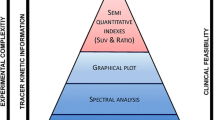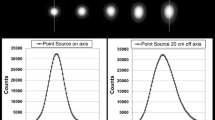Abstract
Positron emission tomography (PET) allows the quantitative in vivo measurement of the regional uptake of radioactive tracers. The low spatial resolution of PET scanners is one of the limiting factors in the absolute quantification of, for example, blood flow and metabolism in small anatomic structures like the cerebral cortex. The direct consequence of the low spatial resolution is a partial loss of the signal in structures which are smaller than twice the resolution of the tomograph (i.e., the full width at half maximum (FWHM)). As a consequence, the affected structures cover only partly the point spread function (PSF) of the scanner [9-11]. The measured PET signal in this case represents a mean activity concentration, which is lower than the real activity concentration. In clinical use, the question often arises, as to whether a decrease in the PET signal corresponds to a lower tissue accumulation or is a consequence of a partial volume effect, or a combination of both.
Access this chapter
Tax calculation will be finalised at checkout
Purchases are for personal use only
Preview
Unable to display preview. Download preview PDF.
Similar content being viewed by others
References
Avril N, Bense S, Ziegler SI, Dose J, Weber W, Laubenbacher Ch, Römer W, Jänicke F, Schwaiger M (1997) Breast imaging with fluorine-18-FDG PET: quantitative image analysis. J Nucl Med 38:1186–1191
Brooks RA, Chiro GD (1976) Principles of computer assisted tomography (CAT). Phys Med Biol 21:689–732
Chen C-H, Muzic RF Jr, Nelson AD, Adler LP (1998) A nonlinear spatially variant object-dependent system model for prediction of partial volume effects and scatter in PET. IEEE Trans Med Imag 17:214–227
Chen C-H, Muzic RF Jr, Nelson AD, Adler LP (1998) Simultaneous recovery of size and radioactivity concentration of small spheroids with PET data. J Nucl Med 40:118–130
Frost JJ, Meltzer CC, Zubieta JK, Links JM, Brakeman P, Stumpf MJ, Kruger M (1996) MR-based correction of partial volume effects in brain PET imaging. In: Myers R, Cunningham V, Bailey D, Jones T (eds) Quantification of Brain Function Using PET. Academic Press, pp 152–157
Held K, Rota Kops E, Krause BJ, Wells WM, Kikinis R, Müller-Gärtner HW (1997) Markov random field segmentation of brain MR images. IEEE Trans Med Imag 16:878–886
Henze E, Huang SC, Ratib O, Hoffman E, Phelps ME, Schelbert HR (1983) Measurement of regional tissue and blood-pool radiotracer concentrations from serial tomo-graphic images of the heart. J Nucl Med 24:987–996
Herrero P, Markham J, Bergmann SR (1989) Quantitation of myocardial blood flow with H2 15O and positron emission tomography: assessment and error analysis of a mathematical approach. J Comput Assist Tomogr 5:862–873
Hoffmann EJ, Huang SC, Phelps ME (1979) Quantitation in positron emission tomography: 1. Effect of object size. J Comput Assist Tomogr 3:299–308
Hoffmann EJ, Huang SC, Plummer D, Phelps ME (1982) Quantitation in positron emission computed tomography: 6. Effect of nonuniform resolution. J Comput Assist Tomogr 5:987–999
Kessler RM, Ellis JR, Eden M (1984) Analysis of emission tomographic scan data: limitations imposed by resolution and background. J Comput Assist Tomogr 3:514–522
Kosugi Y, Sase M, Suganami Y, Momose T, Nishikawa J (1996) Dissolution of partial volume effect in PET by an inversion technique with the MR-embedded neural network model. In: Myers R, Cunningham V, Bailey D, Jones T (eds) Quantification of Brain Function Using PET. Academic Press, pp 166–169
Mazziotta JC, Phelps ME, Plummer D, Kuhl DE (1981) Quantitation in positron emission tomography: 5. Physical-anatomical effects. J Comput Assist Tomogr 5:734–743
Meltzer CC, Leal JP, Mayberg HS, Wagner HN, Frost JJ (1990) Correction of PET data for partial volume effects in human cerebral cortex by MR imaging. J Comput Assist Tomogr 14:561–570
Meltzer CC, Zubieta JK, Links JM, Brakeman P, Stumpf MJ, Frost JJ (1996) MR-based correction of brain PET measurements for heterogeneous gray matter radioactivity distribution. J Cereb Blood Flow Metab 16:650–658
Müller-Gärtner HW, Links JM, Leprince JL, Bryan RN, McVeigh E, Leal JP, Davatzikos C, Frost JJ (1992) Measurement of radiotracer concentration in brain gray matter using positron emission tomography: MR-based correction for partial volume effects. J Cereb Blood Flow Metab 12:571–583
Rota Kops E, Herzog H, Schmid A, Holte S, Feinendegen LE (1990) Performance characteristics of an eight-ring whole body PET scanner. J Comput Assist Tomogr 14:437–445
Rota Kops E, Krause BJ, Herzog H, Müller-Gärtner HW (1998) 3D-Partial volume correction and simulated PET studies. Eur J Nucl Med 25:900 (abstr)
Rousset OG, Ma Y, Kamber M, Evans AC (1993) Three dimensional simulations of radiotracer uptake in deep nuclei of human brain. Comput Med Imaging Graphics 4/5:373–379
Rousset OG, Ma Y, Evans AC (1998) Correction for partial volume effects in PET: principles and validation. J Nucl Med 39:904–911
Videen TO, Perlmutter JS, Mintun MA, Raichle ME (1988) Regional correction of positron emission tomography data for the effects of cerebral atrophy. J Cereb Blood Flow Metab 8:662–670
Editor information
Editors and Affiliations
Rights and permissions
Copyright information
© 2000 Springer-Verlag Berlin Heidelberg
About this chapter
Cite this chapter
Kops, E.R., Krause, B.J. (2000). Partial volume effects/corrections. In: Wieler, H.J., Coleman, R.E. (eds) PET in Clinical Oncology. Steinkopff, Heidelberg. https://doi.org/10.1007/978-3-642-57703-1_4
Download citation
DOI: https://doi.org/10.1007/978-3-642-57703-1_4
Publisher Name: Steinkopff, Heidelberg
Print ISBN: 978-3-642-63329-4
Online ISBN: 978-3-642-57703-1
eBook Packages: Springer Book Archive




